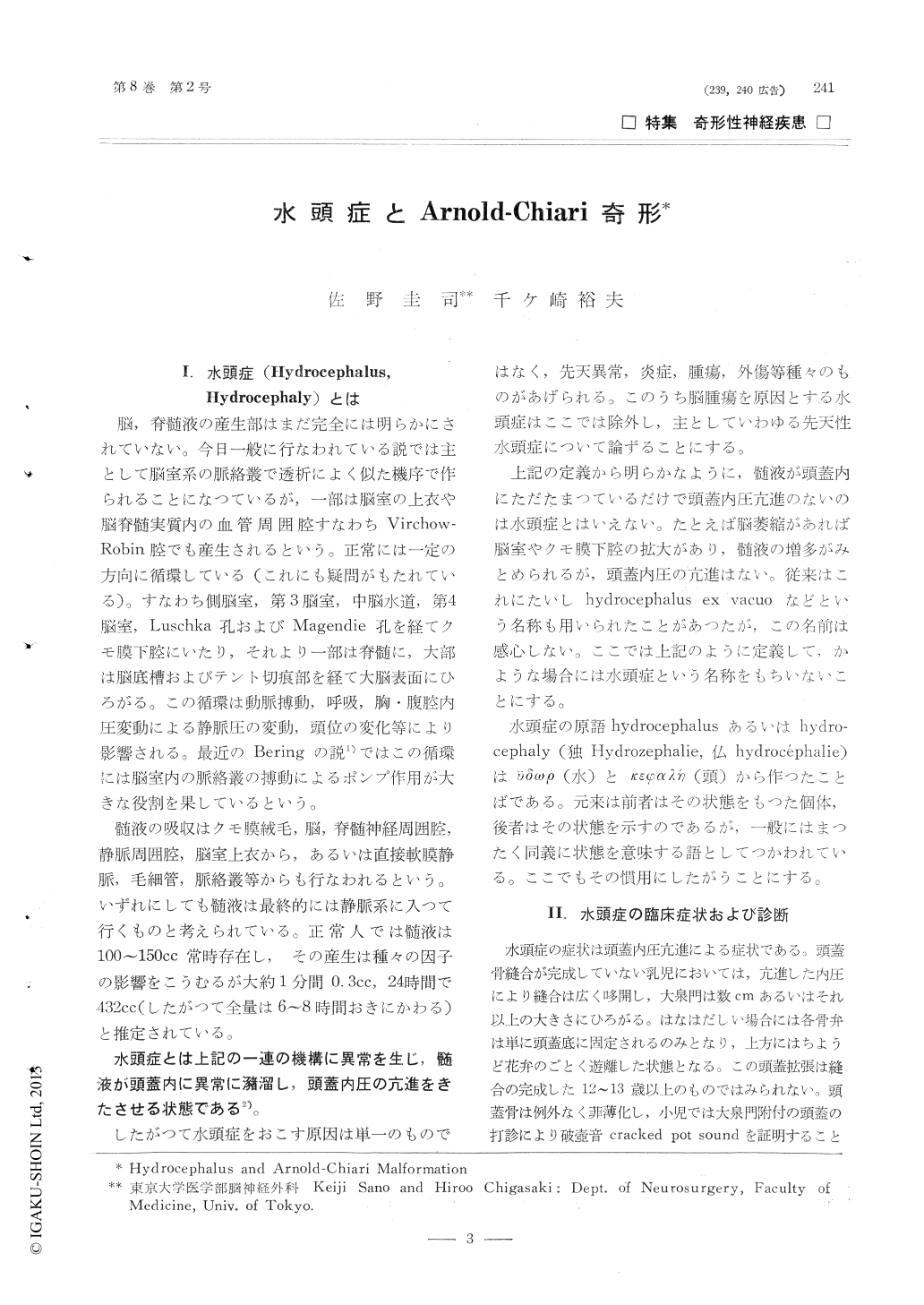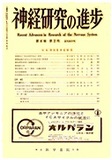Japanese
English
- 有料閲覧
- Abstract 文献概要
- 1ページ目 Look Inside
I.水頭症(Hydrocephalus,Hydrocephaly)とは
脳,脊髄液の産生部はまだ完全には明らかにされていない,今日一般に行なわれている説では主として脳室系の脈絡叢で透析によく似た機序で作られることになつているが,一部は脳室の上衣や脳脊髄実質内の血管周囲腔すなわちVirchow-Robin腔でも産生されるという。正常には一定の方向に循環している(これにも疑問がもたれている)。すなわち側脳室,第3脳室,中脳水道,第4脳室,Luschka孔およびMagendie孔を経てクモ膜下腔にいたり,それより一部は脊髄に,大部は脳底槽およびテント切痕部を経て大脳表面にひろがる。この循環は動脈搏動,呼吸,胸・腹腔内圧変動による静脈圧の変動,頭位の変化等により影響される。最近のBeringの説1)ではこの循環には脳室内の脈絡叢の搏動によるポンプ作用が大きな役割を果しているという。
髄液の吸収はクモ膜絨毛,脳,脊髄神経周囲腔,静脈周囲腔,脳室上衣から,あるいは直接軟膜静脈,毛細管,脈絡叢等からも行なわれるという。いずれにしても髄液は最終的には静脈系に入つて行くものと考えられている。正常人では髄液は100〜150cc常時存在し,その産生は種々の因子の影響をこうむるが大約1分間0.3cc,24時間で432cc(したがつて全量は6〜8時間おきにかわる)と推定されている。
The authors define hydrocephalus as a state inwhich the cerebrospinal fluid accumulates abnormally in the cranium due to the disturbance of production, circulation or absorption of the cerebrospinal fluid to cause intracranial hypertention. During past 10 years, the authors have experienced 123 cases of hydrocephalus andthe Chiari-Arnold syndrome exceptthose due to brain tumors. They include inclde 49 cases of non-communicating type, 18 of communicating type, 7 of hvdroencephalo-dysplasia (dysgenetic hydrocephalus) and 40 of Chiari-Arnold syndrome. The authors prefer the name, "Chiari-Arnold syndrome" to Arnold-Chiari malformation in honour of Hans Chiari, the first describer of this syndrome and devided it into 3 types: 14 cases with spina bifida (S-Type),13 cases without spina bifida (C-type) and 13 cases with basilar impression (B-type). The onset of symptoms in the B- and C-types is mostly after 10 years, whereas the S-type exhibits symptoms before 3 years. The authors discussed about the etiology, symptomatology, diagnosis and treatment of these diseases based on their clinical data. The authors have performed ventriculoatriostomy for hydrocephalus using a silicone rubber tube which was essentially of the same type as ones reported by Pudenz et al. For five years, 29 cases of various kinds of hydrocephalus underwent this operation. The most important point of the operation technique is to insert the tip of the tube with valve precisely into the right atrium. For this purpose, the authors checked the position of the tip by the following methods : 1) measurement of the length between the inserting Point and the right atrium on X-ray films.
2) changes of speed of dripping infusion of physiological saline solution through the tube, as the tube gradually proceeded in the venous system.
3) changes of EKG.
The results of follow-up studis on cases with this operation were as follows : 20 cases were markedly improved (the longest follow-up 4 years), 4 cases showed no improvement and others had recurrence after several months.
The post-operative complycations, such as ventricular fibrillation, convulsion, pulmonary edema, stenosis of the tube and infection (meningitis, sepsis), were seen in 10 cases, of which 5 required revision.
The authors believe that this shunting operation is the most effective for the treatment of hydrocephalus at present and should be made as soon as possible before intracranial hypertention does not cause severe cerbral changes.

Copyright © 1964, Igaku-Shoin Ltd. All rights reserved.


